
Wednesday 10th September Abraham Lincoln revisited 100 miles
The night was cool, but we woke to a blue sky and a beautiful day.
We hot-footed it to Springfield, which we had visited in 2002 when following Route 66. We had visited Lincoln’s home then, so this time drove through the centre, turning north at Walnut St (always our answer to everything), stopping at Oak Ridge Cemetery.
We had coffee sitting on a bench near the Illinois Vietnam War Memorial – 3,000 men from Illinois had lost their lives there.
We thought that we should revisit Lincoln’s tomb – a lot has happened in 6½ years, and we now know much more about Lincoln.
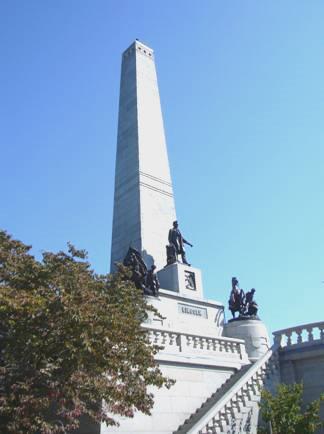
Lincoln’s Tomb at Springfield
The strange thing was, we both felt that when we think back to our time following Route 66, we imagine ourselves to be in our old Morris!
They were doing some reconstruction on the pathways outside the memorial, which made it very noisy. We went inside and listened to a short talk by the guide there. Three of Lincoln’s four sons are also buried in the tomb – none of them reached adulthood. The one who did had no descendants to carry on the line – his own son died young. How often we have found that with great men – Captain Cook being one example.
We now made our way to New Salem, where Lincoln had lived from 1831-8. The village where he lived ‘died with him’ when he left for Springfield – nearby Petersburg took over as the ongoing town.
The village of New Salem has been rebuilt – much of it in 1930s by the Civil Conservation Corps. It is now a state historic park. We first went into the visitors centre, where there was a small museum explaining the significance of this time to Lincoln’s story. After eating lunch, we visited the actual village.
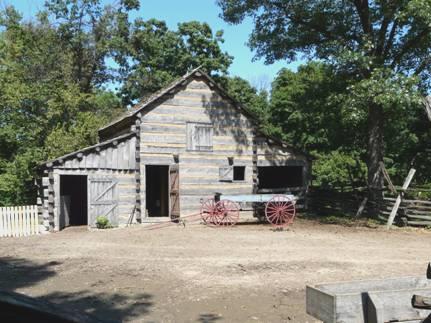
New Salem
It had been excellently reconstructed, and the log buildings looked so evocative, each with its own little simple garden. Butterflies loved the bright orange daisies.
Each building had a short history of its ownership written up on it. In a few of the buildings were costumed voluntary guides. One woman guide proved that not all American women are overweight! She was also quite forthright in her beliefs! She asked about England, and said that she had loved the Queen Mother, and also Di, and Fergie.

Alan Braun, alias Benny Hill
The chap ‘running’ the store looked like Benny Hill as a Bavarian toymaker! It didn’t surprise us to know that he had German ancestors (and also Cornish and Kent). His name was Alan Braun – we chatted for a long time. He and his wife had both worked in the forces, so had spent much time in Europe and the Middle East. He seemed to share our love of travel.
Lincoln had spent his formative years in this village – he had arrived without knowing which path to follow. During his time here, he had had a failed venture in running a store, had spent some time doing ‘service’, was the postmaster, had been the local land surveyor and had studied law, before leaving for Springfield. We were so glad to be able to relive this part of his life, when we have seen so many other relevant places, like his birthplace, childhood cabin and Springfield home.
I investigated the grist mill by the Sangamon River, then we headed north to Havana. Here I had more success with suggesting the ‘City Park’ to stay at, after last night’s disaster!
This one was situated beside the Illinois River – the only downer being that they were working on the river bank, so the place was lined with that ghastly orange ‘fencing’. Having settled in, we had a lovely walk in the warm sun along beside the river. A huge barge went by, on its way to the Mississippi. We wandered around the charming town centre, where nothing much was happening. We were delighted to see a marker stating that Lincoln had arrived here by canoe after serving in the army, en route to New Salem, in 1832.
We came back to enjoy the hot sun.
We cooked on the barbie, then later had a fire. Adrian had spent a long time chopping a huge log left here, but had to give up on it. We had a cat come to visit us for the evening – preferable to a dog, but it was very persistent!
The mozzies are still around, and Adrian got badly bitten.
Thursday 11th September Across the Mississippi into Iowa 124 miles
It was a grey start to the day, which later turned to rain, but became dry and very warm and humid in the afternoon.
We left at 9 o’clock our time (we haven’t changed to Central time yet, as ours - Eastern time - suits us better, making the evenings lighter).
We followed signs to an Indian Mound in the town, but didn’t find any – we had climbed one by the river last night. We drove past pleasant houses, 3 of which had festoons of white loo roll hanging from the trees. We didn’t think that it could be 3 weddings, and decided that perhaps it was to do with being September 11th.
We continued west towards Iowa, stopping for coffee at a place called Good Hope, where there was an unmarked pull off, with just one table far away under a tree.
At La Harpe, we saw a plaque commemorating a visit by Abraham Lincoln on 23rd October 1858, when he was running for senator. The house he stayed in that night was now being restored.
We continued to the rundown little town of Dallas City, beside the Mississippi River. We read a plaque to show that Lincoln had talked here on that day too.

There was an antiquated sign on the side of an old brick building advertising ‘Anguish & Wolfenbarger - Ford’.
Beside it was the relic of an old truck with the same name on the side. The railway ran ride beside this building – after a quick ’ding ding’, the barrier came down across the road, and a huge long train hurled past at enormous speed. None of your 5 minute wait like at Thatcham!
A bit further on we came to our long bridge over the Mississippi. We had been disconcerted to see that it was a toll bridge, but luckily for us, it was only a toll from the other direction. The road bridge ran above the railway, and made strange twists and turns.
We were now in the town of Fort Madison, a pleasant looking town, with lots of nice brick buildings. There was a large riverfront park, but to get to it, you had to cross the railway. Two enormously long trains went by before we could get across. In the park was the restored actual Fort Madison and a rail museum, with a nice Sante Fe engine. A naval boat was docked beside an old paddle steamer, and lots of people were visiting – maybe again to do with September 11th.
We could see the evidence of former floods here. We had seen that we had joined the Mormon Trail, and now found that we had missed Nauvoo, where the Mormons spent the winter of 1845-6 before their trek west. To visit it would mean re-crossing the Mississippi, and as we didn’t know how much was still there, we decided to continue on our way.
Before leaving the town, Adrian phoned the storage place at Bellingham, and confirmed that we will be able to leave the van there in October.
At the town of Bonaparte, we crossed the wide Des Moines River. We pulled into a little Riverside park here, which again showed storm damage. It seemed a good place to stop for the night, so we set off to have a look at the town. It had looked like a film set as we had driven through – we now found that almost all the buildings on Main Street were on the register of Historic Places. Beside the park was a brick mill, and close to that the remains of an old lock. We discovered that it was at this point that Brigham Young, with a band of followers, had crossed the river on 5th March 1846.
We were aware of an unpleasant stench every now and again, like a dead animal – Adrian checked the lockers for the cat!
As it was so warm and humid, we settled on having ‘tea’, rather than cooking. This was complemented by an excellent bottle of dry Riesling.
Friday 12th September Iowa in the rain 134 miles
A disturbed night! It was really warm and because of the light but continuous rain, we had to keep the windows shut. I kept having visions of us being washed down the river!
It was still raining when we woke up, and continued that way all day. We imagine that it is an offshoot of hurricane Ike, as we remember similar weather when Hurricane Katrina was hitting Louisiana. It also remained very warm.
We set off at 8.30 our time.
We very soon came to the charming restored village of Bentonsport. We reached it by a short gravel road. Despite the rain, we took our umbrellas and walked part way across the old bridge over Des Moines River, built in 1882. There were some delightful houses, and a lovely garden built within the foundations of the old mill. A notice said that the garden was being restored after the 2008 floods – we think that a vast area must have suffered in June.
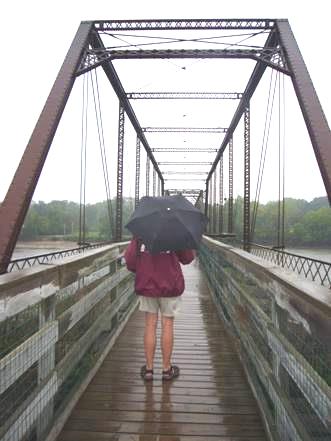
Walking across the bridge in the rain at Bentonsport
We continued to Bloomfield, where we parked by the splendid courthouse to have coffee, and I had a little walk around. There had been nowhere to stop by the road at all.
We were driving through pretty country, but this wasn’t the best day to enjoy it! For most of the time, the road was edged with tall yellow daisy flowers – they had to suffice for our sunshine today! We passed several Amish buggies – luckily they could enclose the cabs – maybe they’re used to wet weather. The roads had numbers /letters like J3T. Signposting left a lot to be desired, and resulted in quite a few ‘uees’. (u turns).
We pulled on to a rough bit of ground in Humeston to have lunch, having again found nowhere else to stop. At Bethlehem, there were a couple of houses and a tiny chapel, with a sign saying ‘rest area’. There was a patch of grass, with one picnic table, but nowhere at all to stop!
We looked at the news, and saw that the travel firm XL had gone bust, and wondered of the implications of it.
We had been loosely following the route that the Mormons had taken on their trek west to establish Salt Lake City. We stopped at Garden Grove, where they had made a temporary camp in 1847. They had erected rough log cabins, with no windows, and the men had set about cultivating the land. Whatever else, they had plenty of guts and perseverance. As we walked out in the torrential rain to view the area of the huts, we tried to imagine the people trudging on in often wet and freezing weather.
Realising that there was going to be no improvement in the weather, we looked through our book to find somewhere to stay for tonight. Little River County Park at Leon came up with the answer. The good thing was it cost only $10, with electricity. Although the ground was quite sodden, we picked a pleasant place above the lake. As it was now raining so torrentially, I thought that I might as well get a bit wetter and have a swim. We drove back to the beach area, and I did just that! The raindrops were bouncing up off the lake, but the water was warm. A huge fish leapt as I reached the waters edge.
We discovered that there were showers here, but the chap was cleaning the ladies. He kindly waited while I had a shower. It was the nicest and cleanest shower block we have come across.
With the rain falling even harder, we made our way back to our spot and had a cup of tea, with a piece of coconut cake bought from a lady at Bonaparte yesterday.
The rain continued relentlessly all evening. After supper we listened to some of our Route 66 travels (when we had lots of rain in Missouri).
Saturday 13th September Winterset – John Wayne, Covered bridges and George Washington Carver 104 miles
It rained all night, and was still raining in the morning. We left and drove on into Leon. We had wanted a Laundrette, but found that the one here closed two weeks ago because of the high cost of water.
As we drove on, we saw that the rivers were full and brown. We were pleased to see glimpses of blue sky, and the day got better and better. The road surface was dreadful, until we came into a new county, and then it changed dramatically.
At Murray we stopped in a roadside park for coffee – Adrian ‘predicted’ that it would have made a good overnighter (Murray Walker joke!).
We now took a 2 mile diversion on a rough road to Mt Pisgah. This was another place where the Mormons had stopped on their trek west. Again they had cleared the land and built cabins. Many of the pilgrims stopped here, and many had died and were buried here. There was an evocative looking log cabin like one that they might have lived in.

Mormon hut at Mt. Pisgah
On our way back to the road, a deer with an enormously long white tail sprang about in front of us.
Now we came to Winterset. This nice town is known for its covered bridges, made famous by the books by Robert James Waller, and made into a film, ‘The Bridges of Madison County’, starring Meryl Streep and Clint Eastwood. We stopped by at the Tourist Information, where a delightful gent told us of some of the treasures of the town. He reminded us of Pat Barker with his quiet sincerity and enthusiasm. He was really interested in history, and had initiated the restoration of a memorial to two local lads who had died in World War 1.
Necessities first, and we located the laundrette while we had lunch. Then we drove on past the birthplace of John Wayne, and later stopped by a memorial to George Washington Carver, who had lived here for two years from 1888. He had been greatly revered here, and had then gone on to study, before leaving for Tuskegee, Alabama, where we had come across him before.
We have tremendous regard for this man born into poverty of slave parents, who went on to have such an influence on agriculture.
There was a campground by the City Park, so we booked in there before going off to see some of the renowned covered bridges. We drove first for nearly 3 miles on a rough track to see the longest bridge, called Holliwell.
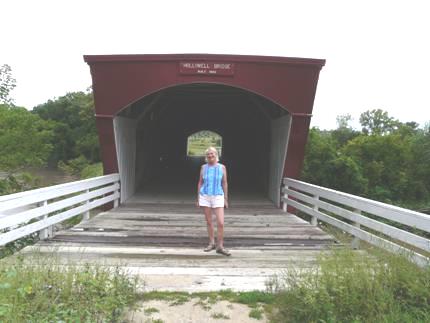
Holliwell covered bridge, Winterset
We have to say that the bridges here are not as pretty as others we have seen. This one, and the next that we visited, called Roseman, feature in the film. Roseman entailed a longer trek – 8 miles, 4 of them on a rough track.
On our return, we passed a wedding party, in 2 carriages, the first pulled by two horses and the second by 2 mules.
Back at the campsite, we made our way into the adjacent City Park, where we walked through a privet maze, viewed yet another covered bridge, and saw a log cabin from 1852. There was also a marker commemorating the discovery of an apple tree in Madison County in 1872, which came to be known as the ‘Delicious apple’, and which subsequently was hybridised to more than 30 varieties.
We got some firewood from the dour and dry camp host, and lit the fire and cooked our meal on it – the first time for a long time. The day had become hot and sunny, but with amazing skies. There were a lot of flying things, but we enjoyed seeing the fireflies before we came in.
I finished reading my book by Dervla Murphy where she walks through the high Andes with her 9 year old daughter and a mule. And we think that we have problems!
Sunday 14th September Pelicans, prairies and precipitation 182 miles
The night was cool and the morning wet and windy – just the morning to enjoy pancakes for breakfast, sitting inside!
We left at 9.30. Our first stop was at nearby Paterson, to see a memorial to two local lads who had been gassed in WW1. Our nice man at the Visitors Centre yesterday had been the force behind restoring the monument, which when it was erected in 1923 had 2,000 people come to honour it. It had fallen into neglect, but now sadly still needs attention, as the recent wet weather has removed the soil beneath it.
At Indianola, where both John Wayne and George Washington Carver had attended the college, there was the usual square around the courthouse. We tried fruitlessly for an internet connection.
We were now skirting Des Moines (pronounced de mon). By the flooded Des Moines River we stopped at a wildlife refuge to have coffee. I had just said that there was nothing to see, when we became aware of hundreds of white pelicans on the water in the distance. On looking up, we saw more circling in the sky. They looked magical in their graceful flight, especially when the sun caught them.
We now made for the Neal Smith wildlife refuge near Prairie City. At this place, they are trying to let the land go back to the prairie that was here before the settlers came. They had removed the farmland and replanted grasses. The Visitors Centre didn’t open until 12.00, which was 1.00 to us, so we had an early lunch before going in. We watched a state of the art film about the history of the prairie. There were very modern exhibits, and the place was busy with visiting children. We afterwards drove around the trail, and did see one large elk.
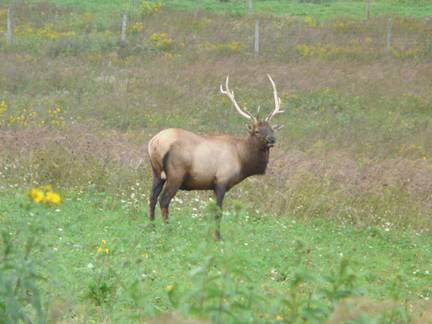
A handsome elk
We drove back to Prairie City, and with difficulty were able to speak to Tom (sounding asleep after a weekend climbing in the mountains), Simon, soon off to Japan, and Emma, who said that at last they had had nice weather in England.
Now the afternoon was slipping away, and we set off to find somewhere to stay for the night. This turned out to be a saga. 80 miles and nearly 3 hours later!!
We first went on a long (7 mile) trek to a park which we had in our book as a free place to camp, but no longer! All the way back, and then on. And on and on! Not one place to pull off the road did we see. At one point we took a smaller parallel road, with no better luck. Ahead of us we could see very black skies – the day had brightened quite considerably until then.
We were heading for the Amana colonies – a group of villages which persecuted Germans had set up in the 1850s. The day deteriorated, and the rain started, and the visibility decreased. Before we could do anything about it, we had reached the Amana villages. There was a campsite here, but we didn’t need one tonight, as we couldn’t take advantage of it – no sitting out around a campfire! As we crossed theIowa River, we could just see flooded land all around. We knew that there was a picnic site, and located it, but it was right beside a pretty, but very high, lily pond, and we couldn’t risk staying there.
There was a smaller campsite in the next village, so we found our way to it, but the dreadful weather meant that no way were we driving onto the grass, so we just stayed on the gravel road as the rain lashed down.
Monday 15th September Memories of Lynton & Lynmouth 150 miles
We had a very rude awakening at 7.00 am (6 o’clock really) when a lorry came to extremely noisily empty the huge dumpster beside us – lucky that we hadn’t parked right in front of it, or we might have been taken too, especially as it was still dark!
We left to have breakfast beside Lily Lake, which was covered in huge waterlily leaves, but the yellow flowers had all finished. The road was incredibly busy – we came to the assumption that the non-stop cars were on their way to the huge nearby factory (Whirlpool’s) for a 7.00 am start.
We watched hundreds of birds flying low over the lake. Outside it was cool and damp.
We now set off on our tour of the six Amana villages. Being early on a Monday morning, nothing much was open. The villagers are known for their art and craft work, their wine making and foodstuffs. We had hoped to get some real ham. All we managed were a couple of loaves at the bakery from a very Germanic woman!
The people here are not to be confused with the Amish, despite their similar name and background. These people are happy to use modern technology.
It was good to see attractive houses built from both stone and brick, with neat gardens full of apple trees and surrounded by wooden fences.
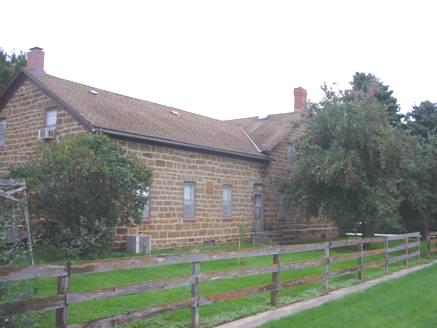
An Amana house
We now drove south of Cedar Rapids, which had been badly affected by the June floods – we had even heard of it in England. The countryside was undulating and agricultural – we had been saying that it made us think of Europe. Then we pulled in to have coffee at Martelle, where even the name seemed French! We were beside a small, sodden park, which even had a ‘Flot Bleu’ (RV dump station) – just like a French Municipal.
At the mid-west looking town called Wyoming, we stopped for some fuel – prices have been doing funny things since Hurricane Ike and like after Katrina, ‘unleaded plus’ is much cheaper than ‘unleaded’.
We stopped to shop at Maquoketa, where it seemed customary for the assistant to take your shopping and load it into your vehicle. We then had lunch, including the rather solid Amana loaf, but at least it wasn’t sweet.
We drove through pretty hilly country with sandstone cliffs to the town of Bellevue, on the Mississippi River. We stopped to see a steamer, and to view the dam.
We now drove north to the town of Dubuque, where we headed for the ‘steepest railway in the world’. We managed to park in the street right by it. It certainly looked steep, if very short. First impressions were that it was like Lynton and Lynmouth Cliff Railway, or like the one at Hastings.
What we loved was the low-key atmosphere. When the ‘carriage’ arrived, you got in, pulled a lever to alert the lady at the top, and when she was ready, the door shut and the car ascended. There was no door at the top side. When we reached the top, we just stepped out.
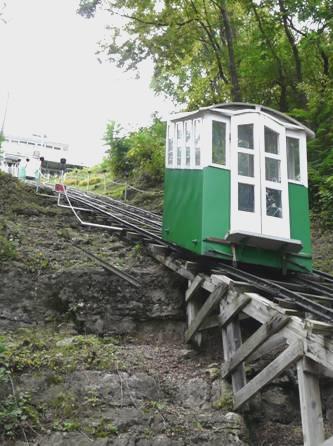
Dubuque ‘elevator’
The railway dated from 1882, when a local man had built it for his own use, so that he could get from his house at the top, to his workplace at the bottom. It has had to be rebuilt several times, because of fire, and now is run by a family as a fun thing for tourists and locals.
There was nothing really to see at the top, so we descended and had a walk around the pleasant town, which showed very little sign of life today.
We had note of several different camping places nearby, so followed a route to Riverside Park, right by the Mississippi River. We could see that the whole place must have been devastated by floods earlier in the year, and now still looked rather wet from the recent rain.
We watched as huge Mississippi barges ambled by, carrying coal up river.
Then, as if by magic, the sun appeared after a very mediocre day. We watched it go down, and then the full moon rise over the Mississippi as a yacht sailed by. Long trains with their colourful orange and green trucks had plied by on the opposite bank, but luckily went behind trees opposite us, so weren’t so noisy. We saw lots of birds fly past as we sat by our campfire –enjoying the warmth this time. A lovely evening.
Tuesday 16th September Not real gamblers 138 miles
We saw the sun come up over the Mississippi River into a clear blue sky – we had been missing this weather, but it did mean a cool start to the day.
The camp chap last night had told us that on Tuesdays you could get breakfast at the adjacent casino for $2, so we thought that we’d give it a go. We had to register first, and wondered if it was all worth it, especially when they couldn’t fathom out my English driving licence, so couldn’t complete the registration. England didn’t fit into their system!
We still wondered if it was worth it, apart from the experience, when we saw all the doddery old people who must have come in to gamble their time away. Many were far overweight, and not a pretty sight!
The breakfast wasn’t all that fantastic – coffee, (no tea), orange juice, melon, bacon, scrambled egg. I made some toast, and we took a donut each in our pocket.
By signing in, we had been given $5 credit each to play. Not being gamblers, this didn’t excite us, but we thought that we’d give it a go. After much trouble, we each put in our $5 worth of credit into adjacent slot machines, not having a clue what we were doing. The funny result was that we made $6.34 between us, so we had paid for our breakfast ($4.26 with tax) with $2 to our credit! We won’t be making a habit of it though!
We now crossed over the Mississippi River into Wisconsin. We stopped at Platteville – which had a very nice Main Street – and Adrian had his missed cup of tea. We drove on through pretty, rolling, rural country – much of USA’s butter and cheese comes from Wisconsin. It was hot when we stopped to have lunch in a little park in Blue River. Unlike its namesake in Canada (1989), we weren’t engulfed in mosquitoes, but we did have wasps to annoy us.
After lunch, I couldn’t resist a short go on the swings. There was a football nearby, and I scored a basketball goal first time!
We now crossed the wide Wisconsin River, which would soon join the Mississippi. We had seen its headwaters a few weeks ago.
There was just a bit of autumn colour in the lovely forested areas we drove through. The route we took (sometimes unintentionally) was really pretty. We reached the Mississippi again at delightful Ferryville, which had just one row of attractive houses above the river. There was a recently made lookout, and we saw another large group pf pelicans on the water. With the blue sky, everywhere looked wonderful.
Adrian received a Happy Birthday message from Paul and Nicky, with gorgeous photos of Louisa.
We now made our way to Black Hawk Park beside the Mississippi River.
We found a place to stay for the night, then headed for the swimming beach, on a sidewater of the river. We waded in, but the water hardly reached our knees!
We hadn’t seen anywhere to buy firewood, and there was none noticeable around the site. This was very aggravating, as it was just the night for a fire, and Adrian’s ‘pre-birthday’. We drove around, and spied just one large log – tree diameter. Not to be outdone, Adrian went to collect it and chopped it up – so we had a fire after all!

Last day of 65!
We cooked a huge ham steak with squash, mushrooms and potatoes, also beans and broccoli. For dessert we had strawberries and cream. We had been the only pitch with sun, and all the flies and mozzieshad congregated, but after the sun went down we had a visit from a kingfisher and a heron. It was really peaceful, and the night was warm. We sat out until late, watching the stars, and the full moon.
Wednesday 17th September Clickety Click into Minnesota – the final state 131 miles
A beautiful day for Adrian’s 66th birthday. After opening his few cards and presents, we ate our scrambled egg outside. Adrian’s ‘Adrian Route 66’ mug seemed very appropriate!
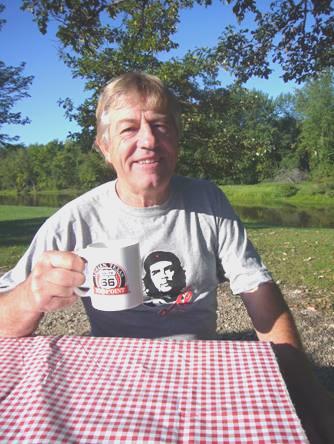
Happy 66th!
We started by driving back a few miles to cross the Mississippi into Iowa, so that we could then drive north into Minnesota. It was about 3 miles across the Mississippi wetlands, and then the actual bridge – the view was splendid as we crossed.
Ten miles later we came to the Minnesota state-line. We were quite excited to be crossing this on Adrian’s birthday, as it is the only one of USA’s 50 States which we hadn’t been to. We stopped to take photos, and to have some of Adrian’s birthday carrot cake.
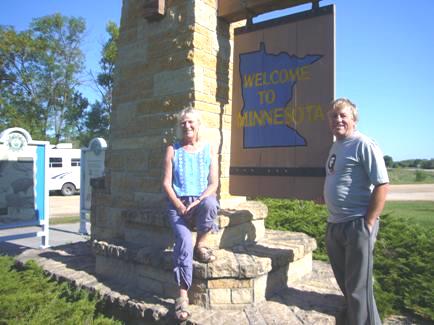
Into the final state
Driving on north, we stopped by several lookouts over the river. Each time we saw pelicans gathered in the water. It was a beautiful drive. We pulled into a rest area and got a few leaflets on Minnesota from the information office. We were just below Dam no 7. Dams were built on this part of the river for navigation purposes, as the river previously was too shallow in places for the steamers. We found a picnic table in a lovely isolated situation above the river to enjoy Adrian’s birthday lunch, which included Amish cheese and Amana bread. The real treat was that there were no flies or any other flying things.
We continued our lovely drive northwards, with views across to the steep bluffs and wooded hills of Wisconsin.
We stopped to get an internet connection in Winona, and Adrian received birthday messages from our other 3 children and from Hil. We sent a message back to her, as it is a year today since Doug’s funeral. We also sent one to Simon to wish them Bon Voyage for their trip to Japan.
Time was rushing away fast – we wanted to stop so that we could enjoy the evening, but needed to be in striking distance of Jack and Rose (from our Central America trip), as we’d said that we’d visit tomorrow.
We were heading for a state park, but when we saw a city park at the town of Lake City, advertising camping, we drove in. After we finally found someone to ask, we found that it was only for tent camping – very unusual, and rather a bummer, as it was a nice situation beside the river. This part of the Mississippi is called Lake Pepin, formed by a natural dam. We’d just stopped to buy firewood from a garage – the first place we’d seen all day selling it.
We drove on the few miles to Frontenac State Park. We saw the sign saying ‘park entrance ½ mile’, and then we came to a long section of roadworks. We had to wait a long time for the ‘stop’ sign to change, and when we emerged at the other end, realised that we must have missed the turning to the park.
Things were beginning to fall apart, as we had to turn around and then wait in the long queue to go back. This time we saw the road we should have taken – there was no indication at all that it was the way to go and it was mostly blocked off with roadwork barriers.
When we finally reached the park office, the pleasant fast talking manager, who looked and spoke like Cliff Richard, was even more frustrated than we were at the lack of signs. He said that he’s been in constant contact with the firm, and whenever he puts up a sign, it’s been removed again. He said that he’d even put on the website the way to go.
We drove off towards the camping area, inadvertently coming to the picnic area first. This was in a fantastic situation high above the river. As an added bonus, a bald eagle flew above our head – we had read all day that bald eagles frequent the river area, but this was the first we’d seen.
Of course when we reached the campsite, it was, as we’d expected, deep in shade, with no views at all. We found the lightest spot we could, where the sun descended through gaps in the trees.
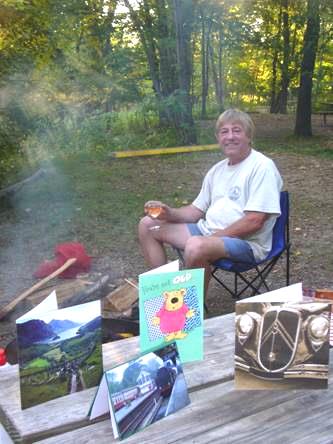
A happy birthday evening
We straight away opened the bubbly, and set to enjoying a lovely birthday evening around our campfire. It was really quiet. At one point a couple had come by and asked if we had found the self registration, to book in. We thought that they were looking for it, and began explaining where it was, as the manager had told us. They then said that they were the camp hosts – they were politely trying to tell us that we hadn’t paid!
Thursday 18th September Just sailing 65 miles
The sun was still deep behind the trees, but we ate our bacon and mushrooms outside. A group of wild turkeys had walked past.
We left to continue on our way to Jack and Roses’ house in Little Canada, part of St Paul, twin city with Minneapolis.
We stopped at the attractive red brick town of Red Wing to have coffee beside the Mississippi River, which at this point looked rather like the Thames! The hanging baskets in the town were still stunning.
At Hastings we crossed the Mississippi River again, but now both sides were in Minnesota.
We found our way easily to Jack and Roses’ place, which is in a lovely situation above a small lake. We sat on their terrace and chatted. After looking around their lovely house and garden, we left with them in their car for Hudson, Wisconsin, about half and hour’s drive away. It is here that they keep their yacht. We spent a lovely afternoon sailing on St. Croix Lake, part of the St Croix River, which joins the Mississippi.

Sailing!
Jack did the leaving and docking by motor, but after that Rose was ‘skipper’ for all the sailing. We just sat and enjoyed ourselves!
We came back to their place where we ate supper and chatted until late. We finally decided to change time zones!
Friday 19th September The Twin Cities
After a long breakfast with much chat, we set off with Rose and Jack to see something of the Twin Cities – Minneapolis and Saint Paul.
We crossed the Mississippi River to Minneapolis on the new bridge which was only opened yesterday after the catastrophic collapse of the previous bridge last August.
Minneapolis combines old and new, with parts of the old mill buildings being incorporated into a modern museum. We visited a state of the art theatre building, from where we had views down over the river and St Anthony Falls, and the old stone and the modern bridges.

With Jack by St Anthony Falls
Rose drove us all around the downtown area, explaining many of the buildings that we passed. Huge churches seemed prominent, including a fine basilica.
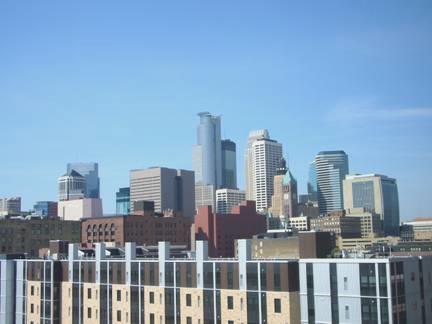
Minneapolis skyline
We walked around a pleasant Sculpture Park, whose centrepiece was a huge cherry (the Mini apple, and the symbol of Minneapolis).

A thorn between two Roses
Green parkland was everywhere, so the whole atmosphere was relaxing.
We stopped at a store called Trader Joe’s, which sold nicer looking food than the normal store. We bought some sandwiches and sushi for lunch, and also got some wine. We drove on to Harriet Park, by one of many lakes, to eat our lunch. It was warm but windy.
We now followed Minnehaha Falls Parkway, and stopped to look at the actual Minnehaha Falls, which luckily looked pretty with water flowing. Nearby was a statue of Hiawatha and Minnehaha. The falls were made famous by Longfellow’s poem, although he apparently never visited them.

Minniehaha Falls
We crossed the Mississippi by another bridge and now had a look at Saint Paul, which I’m glad to say has an attractive cathedral.
We stopped at the ultra modern Science Museum, as there was a film being shown about the Great Lakes, but the next showing wasn’t until this evening, so Rose bought tickets to return then. We had fun climbing up the stairs, which made the sound of an ascending musical scale as we went up them.
After driving around their Little Canada area, we arrived back at the house at about 4.30, as storm clouds gathered but we only had a little shower of rain.
It was hard to tear ourselves away from Rose’s nice chicken curry supper to return to the Science Museum. It did give us a chance to see the city by night. The film was on an Imax screen, and featured many places which we had recently visited, but mostly concentrated on the sturgeon fish, which had been almost wiped out in the last hundred years. It followed the programme to reintroduce the fish to the Great Lakes. It also featured the bald eagle, whose chicks haven’t been surviving to adulthood because of mercury poisoning.
We returned to Jack and Rose’s house and sat chatting and imbibing with them on their terrace until midnight. A large owl had alighted at the top of the fir tree in front of us, so that we could see its silhouette.
Saturday 20th September A taste of Autumn colour 127 miles
After another splendid breakfast, we watched some video of Jack and Rose’s recent trip to India – particularly Ahmedabad, where Jack comes from. It was lovely to relive memories of India.

Canoe(dl)ing
They had a canoe stored down by the lake, so we then both enjoyed a short paddle around the lake before saying our goodbyes to Jack and Rose. It had been lovely to see them and their beautiful home, and they had been excellent hosts.
It was now late morning. We headed out to the attractive but busy brick built town of Stillwater, where we crossed the St Croix River into Wisconsin, and then continued northwards.
It was hot when we stopped to have lunch in a park at pretty Osceola. A bit further on at the nice looking town of St Croix Falls, we stopped to look at the river, but the dam built in the early 1900s means that there are now no longer any falls to see. The hanging baskets in the town were still very pretty.
As we now headed eastwards, and then north-eastwards, we became aware of more and more glorious autumn colours appearing. The road followed the Namekagon River, which flows into the St Croix. Both rivers form the St Croix National Scenic Riverway.
We pulled into a ‘wayside’ above the river, after the town of Spring Brook. It looked like a good place for the night. We were able to walk down to the river on a small trail, which just ended on the river bank. This is a popular river to canoe down, and certainly looks pretty. On the way back a woodpecker flew by.
The evening became cool, so cooking and eating inside wasn’t a problem.
Sunday 21st September Sea Caves of Lake Superior 108 miles
It was a beautiful September morning. We ate our breakfast outside, with the fast flowing river far below us.
We had a nasty moment as we went to leave, when the van wouldn’t start. We had charged the computer on this battery for a short time last night. I turned off the radio, and the engine started, which was possibly coincidence.
We continued on our route to the western end of Lake Superior, reaching it at Washburn where we had coffee beside the lake. It felt quite cool.
After that we shopped in a small IGA supermarket, where we had two nice young lads on the till. A worker in there looked just like Peter Newbury.
We phoned Paul, who said that the weather was still nice and they had just been to the beach.
The peninsula here has several small islands off it called the Apostle Islands, all of which come under the National Lakeshore. A bit of the mainland does too, and we came down to Myers Beach to have lunch.
You had to get a permit to park even though it was a National Park, and Adrian had just made one of his ‘Murray’ predictions – ‘Oh, I don’t suppose anyone will come while we’re here’, when a lady appeared by the van, writing our number on an envelope. She had been standing in a shelter, making sure that nobody got away!
There was a very cool wind on the beach, so we ate our lunch at a picnic table above it, where we could hear, but not see, the lake. It was really hot here.
Having paid our fee (which wasn’t much), we thought that we might as well walk the lakeshore trail, which went along to what was called ‘sea caves’. It was a really pleasant walk through the woods, with lots of ‘ups and downs’, like a mini coastal path. Only one ravine had water in it, but the boards over other places made us realise that it could often be wet!
We were surprised when we reached the viewing area that there were no barriers to speak of, and the terrain was extremely hairy! We could look down to natural bridges and arches. Further along wecame to a series of caves at the foot of sheer high cliffs. Water spurted out of the caves as the waves hit them. Very attractive, but difficult to photograph with all the trees in the way!

The ‘Sea caves’
On our return walk, we watched a woodpecker. We didn’t get back to the van until gone 4 o’clock, but Adrian had an idea of a place to stop for the night just a few miles on near Cornucopia. It was a parking area beside a historic marker, but also right by the lake – a lovely situation.
After a short time we walked along beside the lake to the little working harbour of Cornucopia.
Adrian was keen to have a barbecue tonight, but the millions of flies made this a difficult task! The Amish chicken we cooked, with no additives of any kind, tasted really good.
We had been waiting to watch the sun go down, but as we walked out, it went behind a bank of cloud!
We did have compensation with the stars, which were fantastic.
Monday 22nd September Final farewell to the Great Lakes 116 miles
It felt warm as we ate breakfast outside, and had a little walk along beside the beach.
We set off towards the southwest corner of Lake Superior, stopping at the delightful little town of Port Wing, where there was a replica of the first school bus in Wisconsin – a tiny wagon which would have been pulled by horses, and looked like the ‘child catcher’ from Chitty Chitty Bang Bang.
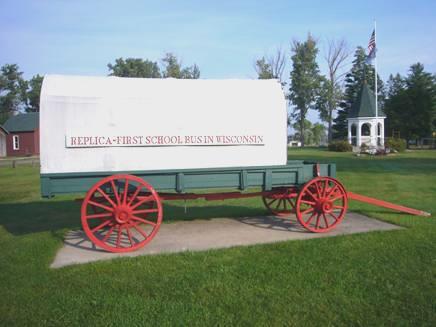
The ‘child catcher’
The town of Superior is twinned with Ami Machi in Japan – we wondered if Simon knew of it.
We crossed on a huge bridge into Duluth, Minnesota, so it was goodbye to Wisconsin. These two towns are huge ports, dealing with vast amounts of grain, also coal, iron and stone.
We found Duluth an attractive town, but could see that it had its parking problems! We headed for the area by the huge ‘Aerial Lift Bridge’, looking rather like our Middlesbrough transporter bridge, but in this case, the whole road bridge lifts up when a boat wants to pass through.
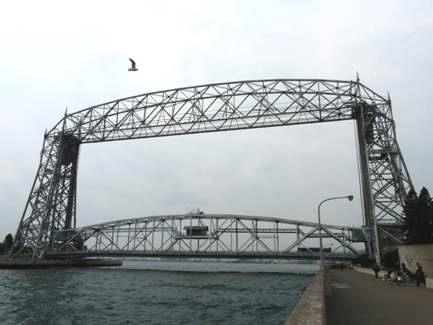

Duluth’s aerial lift bridge A boat passes under the raised bridge
Beside it was a Corps of Engineers museum (which was free, so we only had to pay for parking) with masses of information on the Great Lakes. Although Adrian had said that he was ‘museumed out’, he enjoyed this one! He also loved dashing out to watch the bridge rise. There was even a small section on Lewis & Clark, set up for the bicentenary a few years ago, although their route didn’t touch the Great Lakes.
We were fascinated to see the different depths of the lakes, Superior being by far the deepest, and Erie the shallowest.
Outside it was now cool and cloudy – it seemed like England, with the small lighthouse and anchors, such as we might have at a seaside town.
We stopped to have lunch by ‘The rose garden’, having driven part of Bob Dylan Way – he came from here. We were just out of the busy part of town now, so parking was free. After lunch we walked around the pleasant gardens, where we enjoyed the roses, and also begonias and surfinia petunias. We could see across to the Lift Bridge in the mistiness, so Adrian was able to enjoy it ‘lifting’ again as a huge boat went through. There was a statue to Lief Ericson, founder of America 1,000 years ago, the caption read.
We stopped to get fuel, and I was amused at the sign above the pump which said ‘Always Fresh Coffee’.
We phoned Emma, and found that Ruby is highly excited about being a bridesmaid next Saturday. Paul had emailed photos of Louisa at the beach yesterday.
We’d wanted to drive some of the ‘Skyline Drive’, which is high above the town, but had great trouble in locating it. We did drive a short part of it, and stopped by a delightful chine where waterfalls tumbled down the rocks amidst autumn coloured trees. We didn’t do more, as we wanted to find somewhere to buy a new engine battery for the Bam. Adrian was concerned that we might be let down again by our present one, which has done us well for 6½ years.
We located a ‘Sears’, and they did the job, giving us a $5 credit for Sears, as they had taken longer than they had expected. We hope that we can use it! Next we went into Barnes and Noble bookstore so that Adrian could buy a map to use for the website, as nothing we have covers what he wants.
Now time to head out of Duluth, westwards. We made for a campsite at Floodwood, about 40 miles on. When we reached it, we found it to be a pretty site above the St Louis River, with autumnal trees all around.
The electricity was turned off, and the toilet block locked – it seemed to be closed up for the season, but we set to collecting wood for a fire.
It was lovely sitting out in our isolation, and we enjoyed a campfire for the first time for a while.
Tuesday 23rd September Looking for the Rainbow 93 miles
A short storm heralded the day, which remained grey and miserable, with some outbreaks of rain.
We thought that we’d move off to the nearby rest area to have breakfast, away from the trees. We went the wrong way, so travelled several miles before we realised, and could then turn round. Once at the rest area, I cooked bacon and mushrooms, and then we set off into the Iron Ore hills, which had been a big iron mining area in the past. The scenery was very pretty. We pulled in by what they call here a ‘Wayside Rest’, which was so lovely beside a small lake, with all the autumn colours, that we would have liked to have stopped, had it not been before 10.00 am!
Minnesota is said to have 10,000 lakes. At another, Snowball Lake, I photographed a tree looking brilliant on this dull day.
We now came to the town of Grand Rapids, whose claim to fame is being the birthplace of Judy Garland. The house that she was born in is now a museum. We viewed it, but didn’t go inside.

Judy Garland’s birthplace
We did visit the ‘Old Central School’ – a fine large stone building, which houses a history museum and some tasteful craft shops. Part of the museum was given over to Judy Garland, whose real name we found out was Frances Ethel Gumm! She came from a ‘performing’ family, and with her two older sisters sang on stage from a very early age. The gift shop was full of ‘Wizard of Oz’ things – all we bought were some stickers for Ruby.
We made our way to the ‘Veterans Memorial park’ to have lunch. We were beside the infant Mississippi River, so wandered out afterwards in the dampness to look at the river, which was lined with autumnal trees.
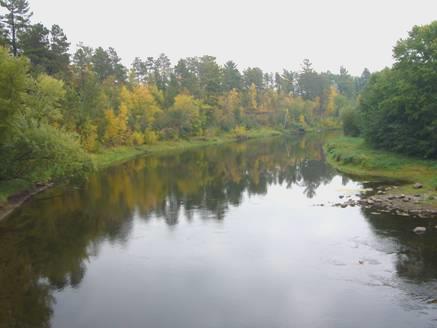
The young Mississippi River
We had a change of plan now, and decided to follow Route 38, which is known as the ‘Edge of the Wilderness Scenic Drive’, and famed for its autumn colours. We were sorry not to be seeing it in sunshine, but sometimes the colours looked vibrant without it.
We thought about stopping early, and when we pulled into a rest area on the ‘Laurentian Divide’, it seemed a good place to stop. From this point, water flows either south to the Mississippi or north towards Hudson Bay.
There was a walk from here, so armed with umbrellas (which weren’t needed) we set off amongst the glorious trees. Many of them looked a vivid lime green, like beech trees in Spring. Appearing through them, we got glimpses of brilliant orange – it often felt as though the sun was shining.
The sun did make an 11th hour appearance, just as it sank behind the trees.
Unlikely as it had seemed, Adrian was still keen to have a barbecue. There were some covered picnic tables, and we actually ate outside, which was a lovely bonus. I had baked some lemon cookies, which we had for ‘pud’.
Wednesday 24th September To the source of the mighty Mississippi 149 miles
The morning was very cool, but the sun was just peeping over the top of the trees as we left at 8.30 – this was a better day for viewing the autumn colours!
We drove on to the town of Blackduck, which had a large model of the same in its nice little park, where we stopped for coffee and more of my good cookies. We phoned Tom, and talked of his plans of going to England at the weekend.
We now drove ‘Scenic Route 39’ south towards Cass Lake. There was a turn-off to Rabideau CCC (Civilian Conservation Corps) camp, one of only 3 of these camps surviving. Franklin Roosevelt had set these up in the thirties at the time of the depression. The men who came were all young unmarried men, who worked on projects such as tree planting and bridge building.

Rabideau CCC Camp
We were greeted by ‘Barb’, a lady in her seventies, who with husband Ken had come here for the last 5 years to act as hosts over the summer. She asked if we’d come for a tour, and by then it was too late to say no! (We found out later that these were only given on Wednesdays and Sundays!)
She took us around the group of buildings which had formed the camp. Some had been restored to appear just as they might have been when in use. After the end of the CCC time, Illinois University had taken over the camp, and used it from 1946 until 1972 for summer schools, which is the reason it has survived.
It was really interesting to find out more about the CCC, and to see an actual camp. Many of the men had arrived poorly educated, and from starving families. They were well fed, and had the chance to improve their education. As a whole, the CCC planted over 3 billion trees and built nearly 47,000 bridges as well as restoring historic buildings and mapping thousands of lakes.
It was now lunchtime, so we drove back a short way to Benjamin Lake, where I made enchiladas as we sat under beautiful autumn foliage.
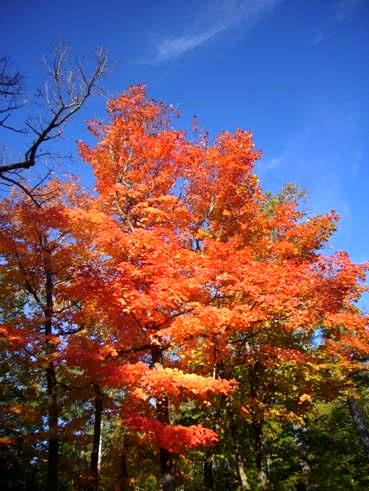
The day was sunny, but with a strong, cool wind. Even so, when I saw that there was a swimming area at the lake, I went in for a short swim, which left me feeling quite rejuvenated.
We drove on into Bemidji, where we stopped by the huge model of legendary superman and hero of logging days, Paul Bunyan, and his blue ox called Babe, whose story we’d known nothing about.
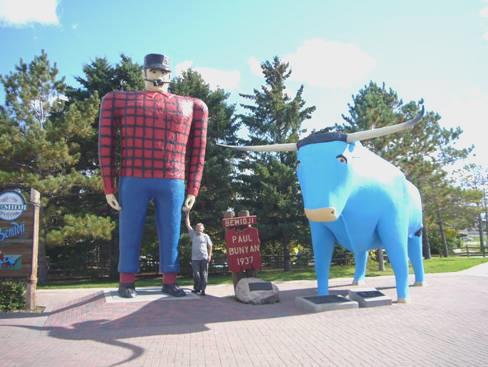
Adrian dwarfed
Now we headed for Itasca State Park, in search of the source of the Mississippi River. On our way there, we crossed the ever diminishing river several times, from where we saw it flowing into BemidjiLake, until it became really tiny.
Once in the park, we stopped to look at some of the masses of information about the Mississippi before walking to the actual source, where it flows from Lake Itasca. We crossed the baby river on a plank bridge, and came back over stepping stones.
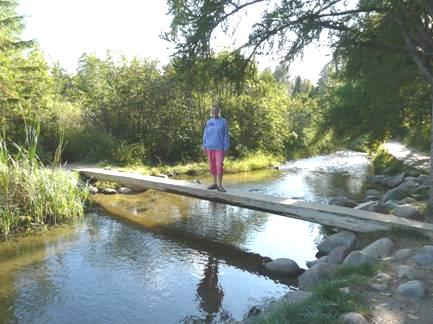
Standing over the Mississippi
It felt really exciting to be here, when we have seen and followed the river at various points as it flows on its 2552 mile route to the Gulf of Mexico.
Now we made for the campsite. We chose a lovely spot by the lake, and Adrian lit the campfire. It was glorious to watch the sun go down over the water, and to then see the stars, which tonight were phenomenal. We’d even seen two deer at dusk.
A Top Spot!
Thursday 25th September Enjoying Itasca Park 57 miles
We had a catching up time, so the sun was just appearing over the trees when we ate our breakfast outside. We devoted the rest of the morning to driving around the ‘Wilderness Drive’, which circles the lake. The total length of the drive was 16 miles.
We’d stopped to ‘dump’ at the prettiest dump station ever – the trees by it were best of all!

What a pretty place to dump
We had coffee beside the lake before continuing our drive. A sign read ‘7 1/5 mile one way’!
There were lots of trails you could walk, some amongst the ancient pine trees, which this park is preserving. There are both red and white pines – the white has needles set in fives, and the red in twos. We walked to the largest of each tree, both said to be over 300 years old. ‘That’s older than our country’ said a man we spoke to. The white pine looked impressive, but the red pine had lost its top. In true parks style, fallen trees had been left in situ – often right across the path! Annoyingly we found that there were still mosquitoes around.
As we continued around the lake, we discovered that the only picnic area in the park was near where we’d stopped for coffee. As booking out time from the campsite wasn’t until 4.00pm, we decided to return to our spot for lunch. When we got there, we found that someone had already set up camp in it for tonight, so we settled on pulling into the next space, which did just as well.
Now 2.00pm, we drove down to the Visitors Centre, stopping at viewpoints by the lake on the way. With the colours so glorious, it was no hardship to repeat the journey!
As we’d expected, the Visitors Centre was full of interesting information about the formation of the park, and the discovery of the source of the Mississippi. The Ojibwe Indians had wondered why finding the actual source was so important – as they said, ‘the whole river is important to us’. The reason was that the Treaty of Paris (1783) had defined the USA territory as extending to all land east of the Mississippi – beyond that was ‘uncharted land’.
There was also more info on the CCC, as there had been a camp in the park, and the corps had built roads, log cabins and stone walls. It was good to enlarge on the knowledge we had gained yesterday of this inspired organisation.
We drove down to have a last look at Lake Itasca, beside the attractive log built lodge (1905), and the atmospheric boat which takes tourists for rides on the lake.
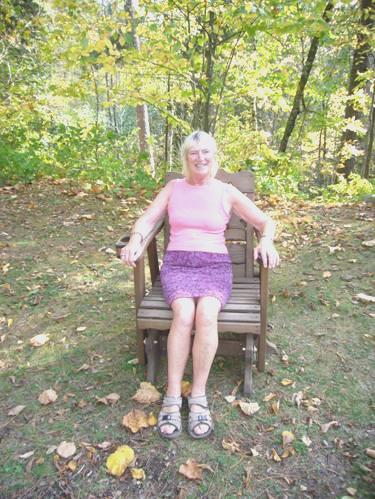
Relaxing in Itasca
Now 4 o’clock, we reluctantly tore ourselves away, and drove south to the town of Park Rapids. Here we got some shopping, before continuing south to Menahga, where we reached a pleasant Municipal forest campsite at 5.30.
We set about collecting up some wood, which Adrian chopped for the fire.
We had a lovely meal, with superb T-bone steak, and came in from our isolation to work on the website.
Forsyth to Menahga, Minnesota









